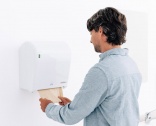Home › magazine › special features › Sustainable washroom strategy
Sustainable washroom strategy
16th of April 2024With reports suggesting consumers are looking for more eco-conscious products, Alasdair Sharp from Satino by WEPA explains how facilities managers can curate a more sustainable hygiene strategy to help achieve the EU’s goal to be climate-neutral by 2050.
AS ENVIRONMENTAL STRATEGIES take centre stage within businesses, one area that may be overlooked is the washroom. Before it’s too late to revert the impact of climate change, businesses must focus on environmental strategies. Highlighted by COP 28 in December 2023, the push to limit the global temperature rise to 1.5 degrees Celsius is more pressing than ever.
The UN Global Compact-Accenture CEO Study on Sustainability found that 84 per cent - of the 1,000 global CEOs surveyed - thought businesses should lead efforts to address global issues, such as environmental damage. Facilities managers need to meet carbon and waste reduction targets by operating a planet-first approach.
Hygiene strategies aren’t often considered within sustainability targets, however, they can have a significant impact. Focusing on the washroom is an accessible way for any business to reduce plastic waste and energy usage.
Pioneering planet-friendly fibres
Hygiene paper used in washrooms is an easy place to start when looking at reducing environmental impact. The paper industry is among the top five most energy-intensive industries and accounts for approximately two per cent of direct industrial CO2 emissions. This has driven innovative advancements meaning there are more alternatives than ever for quality, sustainable, hygiene papers. With the increasing availability of more responsible options, washroom products do not have to come at the detriment of a facility’s green goals.
The pulp and paper industry uses between 33-40 per cent of all industrial wood traded globally. It is a major contributor to deforestation and thereby, to biodiversity loss, species extinction and ecosystem disruptions. Deforestation laws are becoming stricter across the EU, so the importance of alternative fibres is clearer than ever.
Papers made from old corrugated cardboard (OCC) represent the latest revelation from the paper industry in battling deforestation. The production process for turning OCC into paper uses less energy and water compared to methods using raw materials. This is because the shredding and pulping phases are powered by renewable energy sources.
Corrugated cardboard has fibres that are well-suited for recycling, as it is typically made from premium fibres that have already undergone processing. These fibres retain their strength and length, resulting in robust products with a high level of quality and durability.
By choosing hygiene papers made from OCC, facilities managers will boost their eco-initiatives, as they are helping to keep valuable materials within resource streams, contributing to a
more circular economy. When it comes to a facility’s sustainability strategy, the impact a change like this can have on its success is invaluable.
Optimising energy efficiency
Reducing our energy use benefits the economy whilst simultaneously driving sustainability strategies. Touch-free technology is a valuable asset to reduce energy usage in the washroom and can be used for many functions. Touch-free taps that operate on timers help prevent water wastage, offering an environmentally friendly solution. A bonus benefit to touch-free tech is the reduced number of touch points, helping to limit the risk of spreading germs in the washroom.
Touch-free technology is also being used more frequently in the production of paper and soap dispensers. By dispensing the optimum amount of hygiene papers or soap, stock levels are prolonged and over-consumption is prevented. Copious amounts of waste and purchasing vast numbers of supplies can be detrimental to a facility’s sustainability targets, so touch-free technology can be the key to achieving a more planet-friendly facility. As well as limiting damage to the environment, this sustainable solution to energy efficiency also limits expenditure on bills.
Along with reducing water waste use, touch-free tech such as motion sensor lights can help conserve energy by ensuring that lights aren’t left on unnecessarily. This also helps prolong the life of light bulbs, reducing the amount of waste produced from the frequent replacement of light bulbs.
Creating a plastic-free path
Twelve million tonnes of plastic finds its way into the ocean every single year, which equates to eight million pieces of plastic entering the ocean every day, having a significant impact on our marine wildlife and food chain. We are all encouraged to recycle, however, due to the varieties of plastic that can’t be recycled together, only nine per cent of global plastic waste is actually being recycled. Switching to plastic-free items is a small change that facilities managers can make to help shrink environmental impact. It’s paramount to keep a conscious eye on not just the products in the washroom, but the packaging they come in.
Reusable packaging and post-consumer recycled plastic packaging (PCR) reduce the need for virgin materials to be extracted and processed, allowing them to remain in the resource stream. Since January 2023, over 40 per cent of the global population has been living in areas where the generation of plastic has surpassed the available capacity for its management.
The actual liquids that are used in the washroom may be considered a less obvious area to target when facilities managers are striving for a plastic-free washroom. However, these are equally important. Synthetic polymers, which are a liquid form of microplastics, are used in many soaps as a binding agent and film former. These harmful plastics present potential physical and toxicological risks to organisms of a range of sizes and pollute our oceans.
Facilities managers should be aware of supplies containing polyethylene, polypropylene and nylon, as these materials can potentially break down into microplastics and are often found in traditional liquid and foam soaps. Fortunately, sustainable alternatives exist. Choose liquid and foam soaps formulated without microplastics or synthetic polymers to build a greener hygiene strategy. By making informed, environmentally conscious decisions about facility supplies, managers can significantly contribute to microplastic reduction.
Navigating eco-certifications and regulations
With the EU and governments across Europe introducing tighter restrictions on plastic usage, prioritising the environment is not only a choice but, in some cases, a legal requirement. As environmental regulations become more stringent, it is essential to recognise eco-certifications and labels to ensure your business remains compliant with evolving standards.
Key certifications/labels:
• Blue Angel: The Blue Angel focuses on the raw materials used and product safety, with the main focus on environmental and health protection.
• EU Ecolabel: The European Ecolabel makes sure that production processes are carried out according to strict environmental standards. It serves as a guide for everyone who wants to protect the environment by means of product choice.
• FSC (FSC-C016151) and PEFC (PEFC/04-32-0775): FSC and PEFC are wood product certifications for wood from sustainable forestry.
• Cradle to Cradle: The Cradle to Cradle (C2C) concept focuses on designing products with less harmful materials, allowing for reuse or natural degradation.
• ISO: ISO 9000 family is a set of five quality management system standards that ensure businesses meet customer and stakeholder needs within statutory and regulatory requirements.
• Dermatest: Dermatest evaluates the skin compatibility of products directly on humans, providing scientifically substantiated confirmation of product tolerance and safety.
Facilities managers look for the FSC Recycled certified stamp when choosing recyclable hygiene products to ensure the paper comes from responsibly managed forests. EU Ecolabel is another key indicator of environmental commitment. This certification provided by the European Union highlights products that meet strict environmental criteria, covering various product categories including personal care and cleaning.
Recycling infrastructure and regulations may vary by region, so it is essential to be aware of local recycling practices to ensure legitimate commitment to improving the recycling standards of a facility. As the EU sets out its aim to become carbon neutral by 2050, facilities will have no choice but to pay careful attention to eco-certifications and adhere to regulations.
Businesses across all sectors know they must act, as time is of the essence in the fight to reduce carbon emissions and waste. Although it may not seem an obvious point of call, targeting the washroom is an ideal way for any business to boost environmental efforts to significantly reduce plastic waste and energy usage. These changes not only benefit the environment but also contribute to cost savings and a heightened sense of social responsibility.
As facilities across all sectors have washrooms, implementing a more sustainable hygiene strategy is a simple and accessible way for businesses to boost environmental efforts. By adopting a more eco-friendly approach, businesses will not only benefit the environment and conserve finances, but also demonstrate a commitment to corporate social responsibility.












